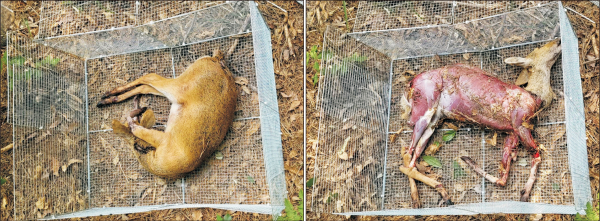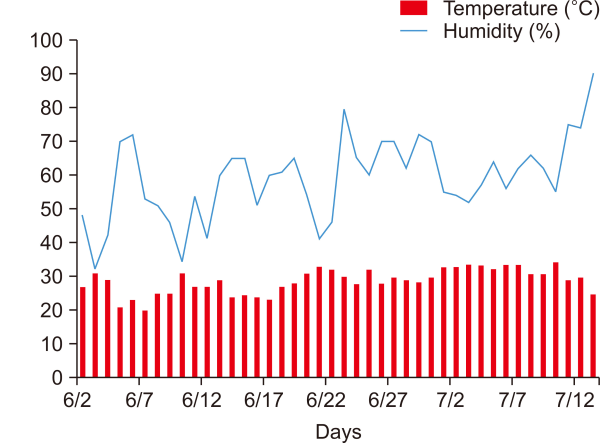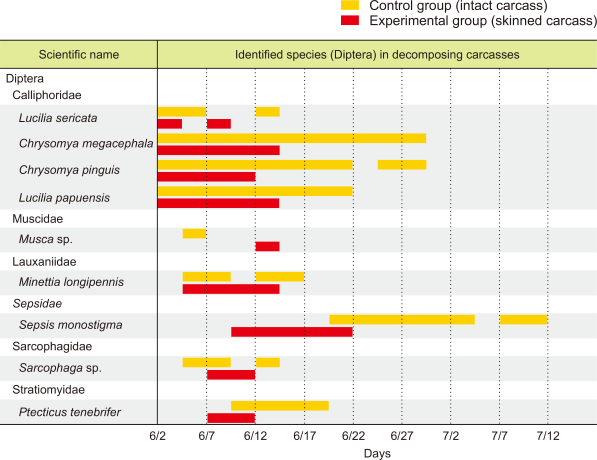Introduction
Forensic entomology is the use of insects found in and around cadavers at crime scenes as legal evidence (Byrd & Tomberlin, 2020; Gennard, 2012; Smith, 1986). After death, the body undergoes various changes, such as decay and decomposition (Yoon, 1993). In addition, various insects are attracted at different stages of decomposition (Benecke, 2001; Byrd & Tomberlin, 2020; Joy et al., 2006). It is possible to estimate the post-mortem interval (PMI) of a cadaver using these insects (Fiedler & Graw, 2003) and this can also be useful for the reconstruction of crime scenes (Anderson & Vanlaerhoven, 1996; Carvalho et al., 2004). Necrophagous insects are particularly important to decomposition, and their biological and ecological impacts are constantly being studied (Geberth, 2015; Moon, 1996). According to the existing literature, cadaver decomposition can vary depending on the body surface characteristics and volume (Amendt et al., 2010; Spector, 1943). In addition, depending on external conditions, such as clothing cover and whether it is buried in soil, differences in the decomposition process and changes in insect behavior may occur (Vasconcelos & Araujo, 2012). In Europe and the USA, there have been reports of differences in insect succession depending on the environmental conditions surrounding a cadaver (Joy et al., 2006), while differences in arthropod communities have been reported based on the level of shelter around a cadaver in South America (Centeno et al., 2002). In addition, physical trauma to a carcass can affect the decomposition rate and arthropod succession, according to a study in South Africa (Kelly et al., 2008), as well as the differences in decomposition and insect succession between clothed and unclothed cadavers (Kelly et al., 2009). In Korea, the decomposition of cadavers, differences in seasonal arthropod succession (Jung & Yoon, 2011; Lim et al., 2011), and differences in Dipteran succession according to decomposition stage have been studied (Lim et al., 2012), however, there is a lack of research on changes in decomposition caused by trauma to cadavers or changes in insect patterns compared to other countries.
In Korea, research is mainly conducted using pigs; however, more research using other wild animals is needed. In a recent study using water deer carcasses, differences in insect succession were reported (Yoon et al., 2022). In addition, wild animals other than pigs have different body surfaces, fur, and hides; therefore, there may be differences in decomposition and insect succession. Currently, forensic entomological research is mainly aimed at PMI estimation, but the differences in insect succession depending on the type of carcass can be applied to reconstructing crime scenes in various ways. For example, the species identified in fur and hides may reveal whether a cadaver was wearing clothing of animal origin (fur, leather, etc.) at the time of death. It can also be used to compare the decomposition of a cadaver according to whether or not clothing was worn. Therefore, it is necessary to continuously accumulate basic data on insect fauna found in various wild animals in addition to pig carcasses. In this study, skinned and intact water deer carcasses were used, in addition to pig carcasses. By comparing the intact and skinned carcasses, each stage of decomposition and the changes in insect succession were investigated according to the exposure of the carcass.
Materials and Methods
Carcass installation
The experiment was conducted using water deer (Hydropotes inermis Swinhoe, 1870) carcasses from the Chungnam Wild Animal Rescue Center. This study was exempt from ethical approval under the ‘dead organism, carcass’ test subject category, in pain grade A in the animal experiment design review criteria of the Institutional Animal Care and Use Committee (APQA & MFDS, 2020).
A site in Cheongyang-gun, Chungcheongnam-do, was selected as the experimental site (Fig. 1). Sites were selected that were surrounded by forest, sparsely populated, and difficult to find. On June 2, 2022, two water deer carcasses were installed in the control group (intact) and experimental group (skinned), which were observed until July 27, 2022 when they became skeletonized. The hides were removed using a 15 cm long knife, and the hides were installed separately to observe the succession of necrophagous insects. To prevent damage to the carcasses by other wild animals, a 110×80×40 cm rectangular parallelepiped wire mesh cage that could be opened and closed was placed over each carcass, as shown in Fig. 2.
Observation of decomposition and insect identification
The decomposition of the carcasses was divided into five stages, according to Centeno et al. (2002): fresh, bloated, active decay, advanced decay, and remainder stage. During the observation period, temperature and humidity were recorded by date using a temperature and humidity meter (CAS digital thermo hygrometer; CAS, Guangzhou, China) and an automatic weather system. After each carcass was installed, daily photography and insect collection were performed. Insects suspected of direct feeding or breeding were collected using insect nets, forceps, and spoons. Eggs, larvae, pupae, and adults were collected from insects identified in the carcasses and stored in 50 mL conical tubes containing 95% ethanol. Collected insects were identified with reference to various illustrated books and literature, and for certain difficult-to-identify species, genetic analysis was performed using the COI primer PolyLCO 5’-GAYTATWTTCAACAAATCATAAAGATATTGG-3', PolyHCO 5’-TAMACTTCWGGGTGACCAAARAATCA-3’ (Carr et al., 2011). Some adults were prepared as dry specimens and stored in the insect specimen room at the National Science Museum, Korea.
Results
Temperature and humidity
From June 2 to July 13, 2022, the average temperature of Cheongyang-gun, Chungcheongnam-do was 28.7°C. The highest temperature was 34.4°C, the lowest temperature was 20.1°C, and the average humidity was 59.1% (Fig. 3). Owing to the seasonal characteristics and nature of the forested area, a high-temperature and high-humidity environment was maintained.
Decomposition and insect succession
It took approximately 41 days for the intact carcass (control) to completely decompose after installation but only 23 days for the skinned carcass (Fig. 4). Calliphoridae were the first insects to arrive immediately after the carcasses were installed, and Coleoptera were identified as decomposition progressed. Decomposition progressed rapidly in the high-temperature, high-humidity environment. Five orders, 15 families, and 21 insect species were collected during the experimental period (Figs. 5Fig. 6-7).
Control group (intact carcass)
Immediately after the carcass was installed, Calliphoridae, including Chrysomya megacephala and Lucilia papuensis, were the first to approach. On June 5, the carcass entered the bloating stage, indicated by the bloating of the abdomen. Dipterans were breeding in areas with relatively thin skin, such as the eyeballs and mucous membranes. On June 7, the carcass entered the active decay stage and a large number of black fly larvae were identified, as well as a large number of Silphidae, such as Necrodes nigricornis and Necrophila brunneicollis, mating on the carcass surface and preying on fly larvae. As decomposition progressed and the carcass dried, the number of insects gradually decreased. From this time on, Dermestes (Dermestinus) tessellatocollis and Necrobia rufipes were identified on the fur and dried hide of the carcass surface (Fig. 8). On June 14, most of the carcass was decomposed and dried and Silphidae and Calliphoridae were identified. D. tesselatocollis and N. rufipes were also consistently identified. On June 28, the carcass was completely decomposed, the bones were exposed, and the insect succession was greatly reduced. A small number of Calliphoridae and Silphidae were identified around the dried carcass, and D. tesselatocollis was confirmed on the fur and hide. Sepsis monostigma and other ants were identified in the dried bones.
Experimental group (skinned carcass)
While the intact carcass entered the bloated stage on June 4, the muscle tissue and intestines of the skinned carcass were actively decomposing, and many Dipteran larvae were found on this date. Inside the carcass, N. nigricornis and Necrophila (Eusilpha) jakowlewi were identified, as well as several other ants. Active decomposition was confirmed for approximately four days, and a large number of insect colonies were identified. On June 8, most of the carcass was decomposed and drying was in progress, and Calliphoridae and a small number of Silphidae bred continuously (Fig. 9). The number of insects was significantly reduced compared with the active decomposition period. After approximately 6 days, the bones were exposed, and skeletonization was confirmed. A small number of Silphidae were identified and pinworms were found in the dried bones. The differences in the types of corruption in each period are shown in Fig. 10.
Decomposition of the hide
After installation, the hide dried quickly over time and Calliphoridae bred inside. Histeridae were identified on the surface of the fur. However, as drying progressed, insect activity was not confirmed (Fig. 11).
Discussion
It took approximately 23 days for the skinned carcass to completely decompose and approximately 41 days for the intact carcass, confirming that the experimental group decomposed approximately 18 days faster than the control group. The experimental group likely decomposed faster than the control group because of the increased area in contact with the external environment after skinning, meaning that insect succession occurred in large quantities. In particular, Calliphoridae were more attracted to the skinned carcass than the intact carcass immediately after installation. This may be due to the abundance of moisture on the surface and its fishy odor. Insect activity increases the decay rate of cadavers, especially necrophagous insects (Rodriguez, 1982). Therefore, it is likely that it was the insect succession rather than the skinning itself that had the greatest effect on the decay rate of the carcass. However, additional experiments should be conducted to examine other factors affecting carcass decomposition in addition to insect succession. Decomposition rate may vary depending on the environmental conditions to which the carcass is exposed, and insect succession can also change accordingly (Kelly et al., 2008). This is reflected by the fact that the intact carcass decomposed at a slower rate than the skinned carcass and insects arrived at the control carcass later than the experimental carcass. In the future, comparative data should be prepared on the rate of decomposition of skinned vs intact cadavers so that it can be applied to PMI estimation.
Slowing decomposition allows for long-term necrophagous insect activity. The fact that the decomposition of the carcass changes according to environmental conditions can be used to estimate PMI in combination with data on the growth stages of necrophagous insects found in the cadaver. Furthermore, D. tesselatocollis and N. rufipes found in the dried fur and hides have already been reported in other research on water deer carcasses (Yoon et al., 2022). In the present study, these species were consistently identified in the dried fur and hide but not in the skinned carcass. Studies show that D. tesselatocollis and N. rufipes are attracted to the dried surface of carcasses for breeding (Hu et al., 2020), but additional experiments are needed to determine whether both the dried surface and the fur or hide affect their habitat choice. Research to utilize these species for field reconstruction is in progress (Hasan et al., 2020; Hu et al., 2020), but there is a need to study new applications for forensic entomology in Korea other than PMI estimation with flies. In each carcass, a large number of Callliphoridae arrived first and as the decomposition progressed, Silphidae and other families were identified. Insect succession differed according to the decomposition stage. By estimating the growth stage of the insect species identified at each stage of decomposition, the indicator species to be applied during forensic entomological field reconstruction may vary (Griasles, 2010).
In the case of the hides, some insects were active before but not after drying. This experiment only included one replicate; therefore, additional experiments are needed to determine whether insects are attracted to hides immediately after installation. Furthermore, the species identified in this study may not be representative of the entire Korean Peninsula. While the results of this study may not yet be applicable in the field, further studies would increase their accuracy and reliability.
Figures
Fig. 9
Insects active on decomposing carcasses. (A) Larvae and adults of Calliphoridae, (B) N. nigricornis.










